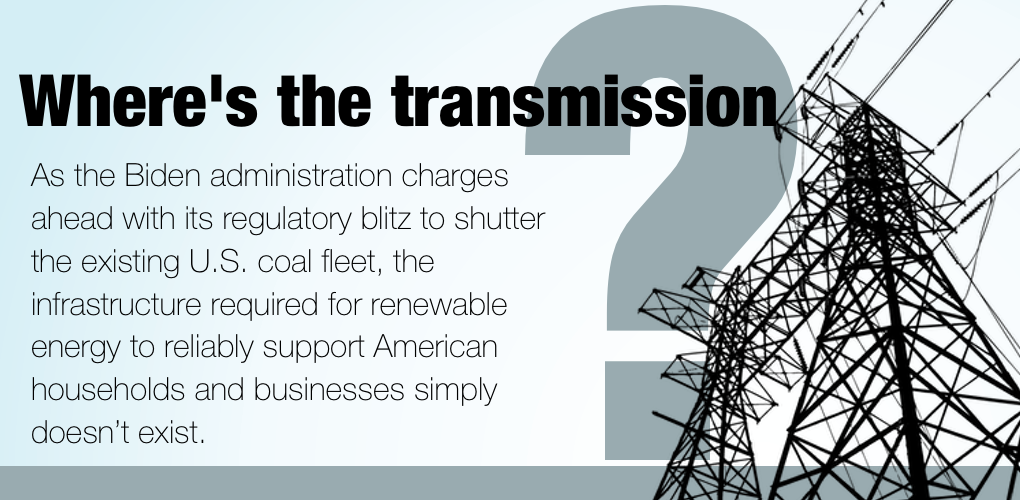
Where’s the Transmission?
As the Biden administration charges ahead with its regulatory blitz to shutter the existing U.S. coal fleet, the infrastructure required for renewable energy to reliably support American households and businesses simply doesn’t exist.
Again and again, experts warn that transmission is the key to building a renewable-heavy future. Analyses from researchers at national labs, the Department of Energy and even Princeton have all concluded a rapid uptick in the historic rate of transmission expansion is essential to manage an electricity system dependent on intermittent power. But that uptick is simply not materializing; in fact, it’s slowing.
According to the Federal Energy Regulatory Commission, high-voltage electric transmission line additions totaled just 552 miles in the first 11 months of 2022, less than half the previous year, and far below what’s needed to facilitate an accelerated move to wind and solar power. According to the National Renewable Energy Laboratory, the U.S. needs to add up to 10,000 miles a year of high voltage transmission to hit the Biden administration’s target of renewable-dominant grid by 2035.
Siting and building the interstate projects that are supposed to be the backbone of this effort is proving all but impossible with no quick fix within reach. According to one consultancy tasked with examining the transmission impasse, the politics of building these projects is so tricky – plagued by nimbyism, fights over who should pay and so many potential hurdles to project approval – that “virtually no major interregional transmission projects have been built in the U.S. over the last decades.”
Even in the places where voter support is strongest for a pivot to renewable power, such as New England, siting and building wind and solar projects – much less transmission lines – isn’t happening.
Money is no silver bullet either. According to the U.S. Energy Information Administration (EIA), transmission spending has increased steadily over the past 20 years but it’s not going to the long distance, interstate projects identified as so important to connecting wind and solar power located in remote areas to urban and industrial demand centers.
The PJM grid, the nation’s largest, is case in point. Spending on transmission in PJM has grown by 14% since 2014 but the vast majority is going towards maintaining existing lines. Spending on new transmission lines has decreased 67% in the same period.
Even natural gas pipelines simply aren’t getting built despite supply chokepoints saddling millions of Americans with scarcity pricing. In fact, according to EIA, in 2022, the least interstate natural gas pipeline capacity was added since data collection began back in 1995.
If transmission and pipeline stagnation is the nation’s reality, why aren’t we reevaluating the pace at which we’re closing what we have?
Between rapidly eroding grid reliability, ever greater concern that the energy transition isn’t moving in an orderly and responsible fashion, and inarguable data that enabling infrastructure simply isn’t keeping up, the case to use the existing coal fleet as a reliability backstop is clearer than ever. But the unfortunate reality is that grid and energy experts aren’t dictating the nation’s energy policy. No, at the steering wheel is the U.S. Environmental Protection Agency (EPA) — the very folks who remain determined to accelerate coal plant retirements regardless of the facts on the ground.
With EPA unwilling to recognize coal’s importance, the immense barriers to integrating wind and solar power and the towering hurdles to building high-voltage interstate transmission, the nation’s reliability crisis will get worse. We’re now all witnesses to a slow-motion train wreck EPA simply refuses to avoid.
- On March 29, 2023
